1. The potential at a point, due to a positive charge
of \[100\mu C\] at a distance of 9m, is
a) \[10^{4}V\]
b) \[10^{5}V\]
c) \[10^{6}V\]
d) \[10^{7}V\]
Explanation: By using

2. Two charges \[+5\mu C\] and \[+10\mu C\] are placed 20 cm
apart. The net electric field at the mid-Point
between the two charges is
a) \[4.5\times 10^{6}\] N/C directed towards \[+5\mu C\]
b) \[4.5\times 10^{6}\] N/C directed towards \[+10\mu C\]
c) \[13.5\times 10^{6}\] N/C directed towards \[+5\mu C\]
d) \[13.5\times 10^{6}\] N/C directed towards \[+10\mu C\]
Explanation:


3.Which of the following is deflected by electric
field
a) X-rays
b) \[\gamma-rays\]
c) Neutrons
d) \[\alpha -particles\]
Explanation:

4.As shown in the figure, charges \[+q\] and \[-q\] are
placed at the vertices B and C of an isosceles
triangle. The potential at the vertex A is
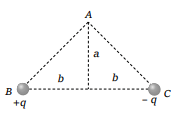
a) \[\frac{1}{4\pi\epsilon_{0}}.\frac{2q}{\sqrt{a^{2}+b^{2}}}\]
b) Zero
c) \[\frac{1}{4\pi\epsilon_{0}}.\frac{q}{\sqrt{a^{2}+b^{2}}}\]
d) \[\frac{1}{4\pi\epsilon_{0}}.\frac{\left(-q\right)}{\sqrt{a^{2}+b^{2}}}\]
Explanation:

5. Consider the points lying on a straight line joining
two fixed opposite charges. Between the charges
there is
a) No point where electric field is zero
b) Only one point where electric field is zero
c) Only one point where potential is zero
d) Both a and c
Explanation: When two opposite charge separated by a certain distance then at two points potential is zero. One point exist between the charges and other exists outside them. Also no point, exists between the opposite charges. Where electric field is zero.
6. A charged particle of mass \[5\times10^{-5}kg\] is held
stationary in space by placing it in an electric
field of strength \[10^{7}NC^{-1}\] directed vertically
downwards. The charge on the particle is
a) \[-20\times10^{-5}\mu C\]
b) \[-5\times10^{-5}\mu C\]
c) \[5\times10^{-5}\mu C\]
d) \[20\times10^{-5}\mu C\]
Explanation:
 Since electric field is acting downward so for
balance charge must be negative.
Since electric field is acting downward so for
balance charge must be negative.
7. Three charges \[Q,+q\] and \[+q\] are placed at the
vertices of a right-angled isosceles triangle as
shown. The net electrostatic energy of the
configuration is zero if Q is equal to
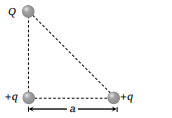
a) \[\frac{-q}{1+\sqrt{2}}\]
b) \[\frac{-2q}{2+\sqrt{2}}\]
c) \[-2q\]
d) \[+q\]
Explanation: Net electrostatic energy

8. Two electric charges \[12\mu C\] and \[-6\mu C\] are placed
20 cm apart in air. There will be a point P on the
line joining these charges and outside the region
between them, at which the electric potential is
zero. The distance of P from \[-6\mu C\] charge is
a) 0.10 m
b) 0.15 m
c) 0.20 m
d) 0.25 m
Explanation:
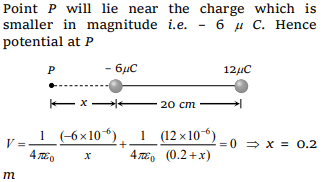
9.In the given figure distance of the point from A
where the electric field is zero is

a) 20 cm
b) 10 cm
c) 33 cm
d) None of these
Explanation:
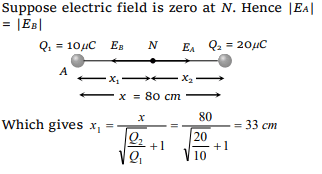
10. Figures below show regular hexagons, with
charges at the vertices. In which of the following
cases the electric field at the centre is not zero
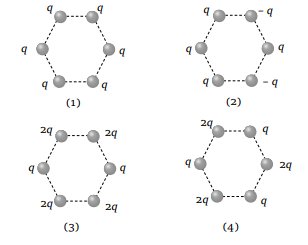
a) 1
b) 2
c) 3
d) 4
Explanation: Electric field at a point due to positive charge acts away from the charge and due to negative charge it act’s towards the charge.
